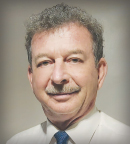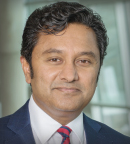In this installment of The ASCO Post’s Global Oncology series, Guest Editor Chandrakanth Are, MBBS, MBA, FRCS, FACS, spoke with Gregorio Jaimovich, MD, Director of the Bone Marrow Transplant Program at Favaloro University Hospital in Buenos Aires. Distinguished expert on radiation therapy and bone marrow transplantation, Robert Peter Gale, MD, PhD, DSc (hc), FACP, FRCPI (hon), FRSM, joined the interview to offer a bit of insight as well.

Gregorio Jaimovich, MD

Robert Peter Gale, MD, PhD, DSc (hc), FACP, FRCPI (hon), FRSM
In 1980, Gregorio Jaimovich, MD, received his medical degree from the University of Buenos Aires, where he remained for his medical residency and hematology training. During his training, the Falklands War broke out between Great Britain and Argentina. “It was a very difficult time for us in 1982 when the war broke out. A year later, I began my residency at the Ramos Mejia Hospital and finished in 1989, serving as Chief Resident for 2 years. After that, I went to New York City and trained in bone marrow transplantation. It was a terrific experience, and I returned to Buenos Aires in 1990 to begin my own bone marrow transplant project in a private hospital with 400 beds. Today, I manage three different bone marrow transplant units in Buenos Aires and perform more than 200 transplants per year,” said Dr. Jaimovich.
Asked about his decision to pursue a career in oncology, Dr. Jaimovich commented: “Hematologists in Argentina and Latin America work with leukemia, lymphoma, and myeloma, not with solid cancers. Moreover, in those days in hematology, you could make a diagnosis with very little gear, just a microscope and hematoxylin plus eosin stain. So, you could diagnose leukemia and immediately begin treating the patient. After that, it became more complex. And when I was a student, it was very difficult for me to understand the classification of leukemias; it took me hours and hours. And because of that and the new things that were happening, I decided to pursue blood cancers and, of course, bone marrow transplantation.”
Fiscal Challenges
Dr. Are noted that he had been in Buenos Aires in 2010, a city he noted was referred to as the Paris of South America. However, Dr. Jaimovich pointed out that a lot has changed since then, as the economy, which was experiencing major convulsions prior to the COVID-19 pandemic, has been hobbled by the mandatory shutdowns.
Dr. Jaimovich explained: “The most pernicious problem in Argentina remains inflation, which affects businesses, households, and the health-care system. The inflation rate this past year was 50% and rising. When we work with a transplant cost, we compare the cost and use a specific formula to equate the acquisition power of the people with the cost of transplant. To give you an idea of how inflation has increased the cost of bone marrow transplantation, when you were in Buenos Aires in 2010, $1 was 10 pesos; now $1 is 180 pesos. So, the cost of an already expensive treatment has greatly increased, which naturally affects access.”
GUEST EDITOR

Chandrakanth Are, MBBS, MBA, FRCS, FACS
Burdens and Trends
Dr. Jaimovich remembered a call he received out of the blue from the President of the World Bone Marrow Transplant Network, which initiated his launching of the Latin America branch. “We started with a survey to calculate the number of transplants we were performing in Latin America in each country. Hematopoietic cell transplantation began in Latin America in the early 1980s. Since then, there has been a steady increase in transplantation rates despite the technical complexity and considerable expense. In fact, 13 of 28 countries in Latin America have established transplantation programs. In 2011, experts from these countries formed a Latin America Bone Marrow Transplant Group (LABMT), which has subsequently conducted annual surveys of transplantation activity in the region.”
Dr. Jaimovich continued: “For the first time, with this kind of survey, we got real numbers. This began in 2013, and since then we’re conducting another survey. And, with these new figures, we will be able to correlate the number of transplants with cost, which will give us a better picture of the health-care value of this work.”
Their first publication of survey results was in 2017. “In total, 94 teams from 12 countries reported 11,519 transplants, including 7,033 autotransplants and 4,486 allotransplants,” shared Dr. Jaimovich. “Annual activity increased from 2,517 transplants in 2009 to 3,263 in 2012—a 30% uptick. Even so, this rate is substantially lower than that in North American and European regions but higher than that in the Eastern Mediterranean and Asia Pacific regions. However, the Latin America transplant rate is fivefold to eightfold lower than that in America and Europe, suggesting a need to increase transplant availability.”
In May of this year, Dr. Jaimovich and coauthor Robert Peter Gale, MD, PhD, DSc (hc), FACP, FRCPI (hon), FRSM, published an article on the paradox of hematopoietic cell transplant in Latin America in the journal Bone Marrow Transplantation.1 They found significant correlations among higher transplant cost, public funding, and transplants in private hospitals with transplant rate.
Dr. Jaimovich elaborated on these findings: “Low cost per transplant regardless of payer and transplants done in public hospitals were associated with low transplant rates. In contrast, high cost per transplant funded by the government and transplants done in private hospitals were associated with high transplant rates. Surprisingly, we found transplant rates were higher when transplants cost more, when they were done in private for-profit hospitals, and when they were paid for with public funds. These data give insights into how to increase transplant rates in Latin America and other developing regions.”
Still Difficult to Quantify Progress
In terms of quantifying progress in terms of the numbers and outcomes in transplantation, Dr. Jaimovich noted the challenges faced by researchers. “We have made basic progress. However, it is not mandatory to report malignant hematologic diseases. So, it’s very difficult to know the current numbers. One example is multiple myeloma, which is about 50% of our documented transplants. However, multiple myeloma remains largely undiagnosed in Argentina, and most of these cases are treated because of bone pain without a specific diagnosis. The same is true for some patients with lymphoma. Our problem is accessing the data from the different areas of our country, which has a very heterogeneous population,” he said.
Barriers to Access
According to Dr. Jaimovich, Argentina has achieved nominal universal health coverage, and the health-care system still needs to work on achieving effective universal health coverage, especially with regard to quality and equity. Nominal coverage means that everyone has been enrolled and has the right to access, and effective coverage means that people have received prioritized health-care services. “The laws establish the right for citizens to obtain free transplantation; however, those with private insurance generally receive transplant services quicker than those on public plans. Children, even those without private plans, usually get priority selection, but private coverage is always better,” he explained.
About 30% of transplants [in the developing world] are performed with unrelated donors, which is different from the developed world, where more than half of the donors are unrelated.— Gregorio Jaimovich, MD
Tweet this quote
Dr. Jaimovich continued: “Argentina’s population is about 42 million, and we currently have 30 bone marrow transplant centers, most of which are situated in big cities like Buenos Aires and Córdoba. We are doing 1,500 transplants per year now, but since the centers are mostly in large cities, it creates an access problem for those individuals in rural areas who might need the service. That access problem is basically the same over much of the developing world. About 30% of transplants are performed with unrelated donors, which is different from the developed world, where more than half of the donors are unrelated. A graft procurement is between $20,000 and $30,000; as a result, there is a growing use of haploid donors. So now, the number of haploid donors is almost the same as unrelated transplants.”
Moving Forward
Dr. Are noted the substantial progress and asked Dr. Jaimovich what three measures are needed to further improve access to high-quality transplant services. “First of all, transplants, especially allotransplants, require a sophisticated health-care infrastructure. Although transplants are typically performed by hematologists, expertise is needed in other disciplines, such as histocompatibility testing, blood banking, infectious diseases, pathology, and pharmacy. So, identifying the needs of the system is important to fill in the proper personnel. In short, we need more centers that are equipped to deliver transplant services.
Second, we need to have a target number for investment, so we can present it to the government. We need more dollars allocated to this vital health-care sector, period.
Third, we need to work on the access issue I talked about previously for those many poor Argentinians who need to travel great distances to receive a transplant. To that end, there are several ways to modify the system, such as using smaller, less costly facilities. It’s a huge challenge, but one we must face up to.”
Prof. Gale Weighs in on Challenges of Cost and Access
According to Prof. Gale, transplant experts in Latin America face important challenges, one of which is a lack of comprehensive data reporting, which can help to identify and advance regional access issues. “The reality is transplants are a high-technology, expensive undertaking for physicians and health authorities in resource-poor geospaces,” Dr. Gale explained. “Progress requires advances outside the direct medical sphere, including political and social involvement arenas. The knee-jerk assumption regarding diffusion of high technology is that the rate-limiting step is the cost. So, logically if we could reduce the cost of hematopoietic cell transplants, numbers of procedures would increase. But, as we present in Professor Jaimovich’s article,1 a contradiction to the perceived wisdom: The less expensive a transplant is the fewer are done, whereas the more expensive the transplant is, the more are done.”
Prof. Gale continued: “It’s exactly the opposite of what we in resource-rich geospaces think, and you have to ask yourself, why? So, when a transplant is very inexpensive, the incentive to the physician to get involved is small. In addition, the incentive to the institution to get involved is very small. This phenomenon doesn’t impugn the dedicated doctors in this very challenging field, but it does prompt a discussion about how the health-care system at large operates, so we can improve equity in health care.”
Closing Thoughts
“It is very important for us to increase our exchange of knowledge with developed countries, so we may gain further insight into the delivery of transplant services,” concluded Dr. Jaimovich. “We need to create robust exchange programs, so we in the developing world can visit centers of excellence and have our young fellows receive training opportunities. Transplantation is an international issue, and it must be treated as such. ASCO and other leading organizations have created global outreach programs, but there’s a lot of work ahead.”
DISCLOSURE: Dr. Jaimovich reported no conflicts of interest. Dr. Gale acknowledges support from the UK National Institute of Health Research funding scheme; and has served as a consultant or advisor for BeiGene Ltd., Fusion Pharma LLC, LaJolla NanoMedical Inc., MingSight Pharmaceuticals Inc., CStone Pharmaceuticals, NexImmune Inc., Prolacta Bioscience, Antengene Biotech LLC, FFF Enterprises Inc., AZAC Inc., Russian Foundation for Cancer Research Support, and StemRad Ltd.
REFERENCE
1. Jaimovich G, Gale RP, Hanesman I, et al: The paradox of haematopoietic cell transplant in Latin America. Bone Marrow Transplant. May 13, 2021 (early release online).

